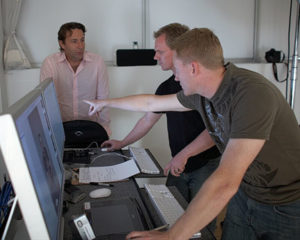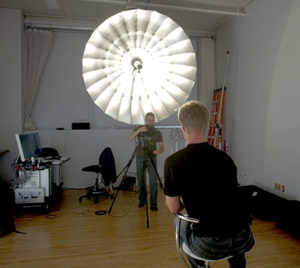Testing Tethered Systems in the Studio

Click the image for a link to a Videoblog (mainly audio) report,
but do read the article below first.
Pros don’t take anything on faith. Not when their livelihood depends on it. And when you’re in the business of providing products and services to professionals, that’s doubly true. Specs or test reports may claim that one camera is faster than another, that a certain computer is “fast enough“, or that one brand of raw software is superior to another. But, without determining these things for oneself, no pro is going to bet their livelihood on someone else’s opinion.
In early October, 2006, I was invited for a visit by my friend Craig Samuel, who runs Studio One, a high-end professional multi-studio / image capture / equipment rental facility in Toronto, Canada. Local as well as visiting pros from around the world use Studio One’s facilities, and are very demanding in their requirements. Speed is among the top requirements when it comes to digital capture (which the vast majority use), though quality can never be compromised just for the sake of speed.
The reason for the invite was that Craig and two of his digital capture operators, Justin Fabian and Chris Nefs, were going to be testing a new capture set up. Two new products have just become available; Mac Pro computers with Dual Core Quad Intel processors, and Phase One’s Capture One 3.7.5, which is a universal binary, and which has recently been re-optimised for tethered capture with Phase One backs. Till now Studio One’s standard capture setup has been Mac G5 Dual 2.5 towers using previous versions of Capture One. The systems include RAID 0 drives and 30″ Apple Cinemadisplays. File format on the P30’s raw files was IIQ Raw – Large.
Parenthetically, I asked why Capture One software was used by preference, rather than something else. I was told that the reason was its wide comparability with a range of DSLRs that are popular with pros, as well as, of course, Phase One backs. Secondly, image quality is regarded as second to none. Thirdly, its workflow is highly regarded by the operators that have to do the heavy lifting on a major shoot, and fourthly, it is known and well liked by most visiting photographers and art directors. Of course if someone is going to be shooting with a brand of back that isn’t supported by Capture One, then that system’s software will be used, but as a rule Capture One Pro is Studio One’s standard.
_______________________________________________________________________________
The Need for Speed
Why is speed important? Because, as the saying goes – time is money. A typical studio shoot, be it fashion, celebrity, or product, can generate many hundreds to a thousand or more images in a day. Photographers almost always shoot tethered in the studio, and when they do this creates a number of bottleneck, including…
– speed of capture
– speed of transfer
– speed of preview generation
– raw processing speed
– speed of generating initially corrected jpgs, work files, and final client files
If capture speed is too slow, the photographer gets frustrated. If transfer speed and thumbnail generation is too slow, the client and art director get frustrated. And, if processing speed is too slow, post production is slowed down, and operators have to stay late – generating overtime, not to mention unhappy wives nursing cold suppers. Oh yes, and clients wonder they can’t have everything – NOW.
Such is life in the fast lane, or at least what one would wish was the faster lane.
_______________________________________________________________________________
The Test
The test setup that day consisted of two identical carts. The current standard system at the studio is a Mac G5 Dual 2.5 Ghz, RAID 0 disk, and 30″ Cinemadisplay. The new challenger was a Mac Pro Quad tower with similar support. Both systems had 4GB of RAM. Cameras tested were a Canon 1Ds MKII, and a Phase One P30 back on a Hasselblad H1. Both cameras were operated tethered.
The testing took much of the day, with repeated timings in various configurations. I dropped in just as the shooting was being concluded and the results tallied. I had an audio recorder with me, and (of course) a camera, and so I documented the setup with a few stills, and recorded the summary discussion between Craig, Justin and Chris.
Linked here is a brief videoblog of this conversation. This is primarily an audio report, with the animated stills there simply for visual interest. Studio One has kindly tabulated the results, and these are available here for download as PDF files, so it might be worth obtaining the files either before or after you watch / listen to the Videoblog.

Click the image for a link to a Videoblog (mainly audio) report
_______________________________________________________________________________
Some Observations
The results are both interesting and surprising. Would you have believed that a Phase P30 back (and likely all Phase backs) actually can shoot tethered faster than a Canon 1Ds MKII? I wouldn’t have beforehand.
That the new Intel Mac Pros are faster than the old G5 Dual Processors is no surprise. But the extent to which Capture One 3.7.5 has been optimized to increase tethered shooting speed with Phase backs is astonishing. Whether we’ll ever see this optimization for shooting tethered with DSLRs remains to be seen. In the meantime, Studio One now knows the answers to their questions, and hopefully you now have a bit of an insight into the subject as well.
One final thought – Phase One has announced Version 4 of Capture One for release some time later this year in an LE version, and next year in a Pro version. I saw a demo at Photokina and Phase One’s own benchmarks show it to be several times faster than the current 3.7.x, with some optimization still to come. Interesting times.
October, 2006

Lorem ipsum dolor sit amet, consectetur adipiscing elit, sed do eiusmod tempor incididunt ut labore et dolore magna aliqua. Ut enim ad minim veniam, quis nostrud exercitation ullamco laboris nisi ut aliquip ex ea commodo consequat. Duis aute irure dolor in reprehenderit in voluptate velit esse cillum dolore eu fugiat nulla pariatur. Excepteur sint occaecat cupidatat non proident, sunt in culpa qui officia deserunt mollit anim id est laborum.
Lorem ipsum dolor sit amet, consectetur adipiscing elit, sed do eiusmod tempor incididunt ut labore et dolore magna aliqua. Ut enim ad minim veniam, quis nostrud exercitation ullamco laboris nisi ut aliquip ex ea commodo consequat. Duis aute irure dolor in reprehenderit in voluptate velit esse cillum dolore eu fugiat nulla pariatur. Excepteur sint occaecat cupidatat non proident, sunt in culpa qui officia deserunt mollit anim id est laborum.
Lorem ipsum dolor sit amet, consectetur adipiscing elit, sed do eiusmod tempor incididunt ut labore et dolore magna aliqua. Ut enim ad minim veniam, quis nostrud exercitation ullamco laboris nisi ut aliquip ex ea commodo consequat. Duis aute irure dolor in reprehenderit in voluptate velit esse cillum dolore eu fugiat nulla pariatur. Excepteur sint occaecat cupidatat non proident, sunt in culpa qui officia deserunt mollit anim id est laborum.
Lorem ipsum dolor sit amet, consectetur adipiscing elit, sed do eiusmod tempor incididunt ut labore et dolore magna aliqua. Ut enim ad minim veniam, quis nostrud exercitation ullamco laboris nisi ut aliquip ex ea commodo consequat. Duis aute irure dolor in reprehenderit in voluptate velit esse cillum dolore eu fugiat nulla pariatur. Excepteur sint occaecat cupidatat non proident, sunt in culpa qui officia deserunt mollit anim id est laborum.

Lorem ipsum dolor sit amet, consectetur adipiscing elit, sed do eiusmod tempor incididunt ut labore et dolore magna aliqua. Ut enim ad minim veniam, quis nostrud exercitation ullamco laboris nisi ut aliquip ex ea commodo consequat. Duis aute irure dolor in reprehenderit in voluptate velit esse cillum dolore eu fugiat nulla pariatur. Excepteur sint occaecat cupidatat non proident, sunt in culpa qui officia deserunt mollit anim id est laborum.
Lorem ipsum dolor sit amet, consectetur adipiscing elit, sed do eiusmod tempor incididunt ut labore et dolore magna aliqua. Ut enim ad minim veniam, quis nostrud exercitation ullamco laboris nisi ut aliquip ex ea commodo consequat. Duis aute irure dolor in reprehenderit in voluptate velit esse cillum dolore eu fugiat nulla pariatur. Excepteur sint occaecat cupidatat non proident, sunt in culpa qui officia deserunt mollit anim id est laborum.


